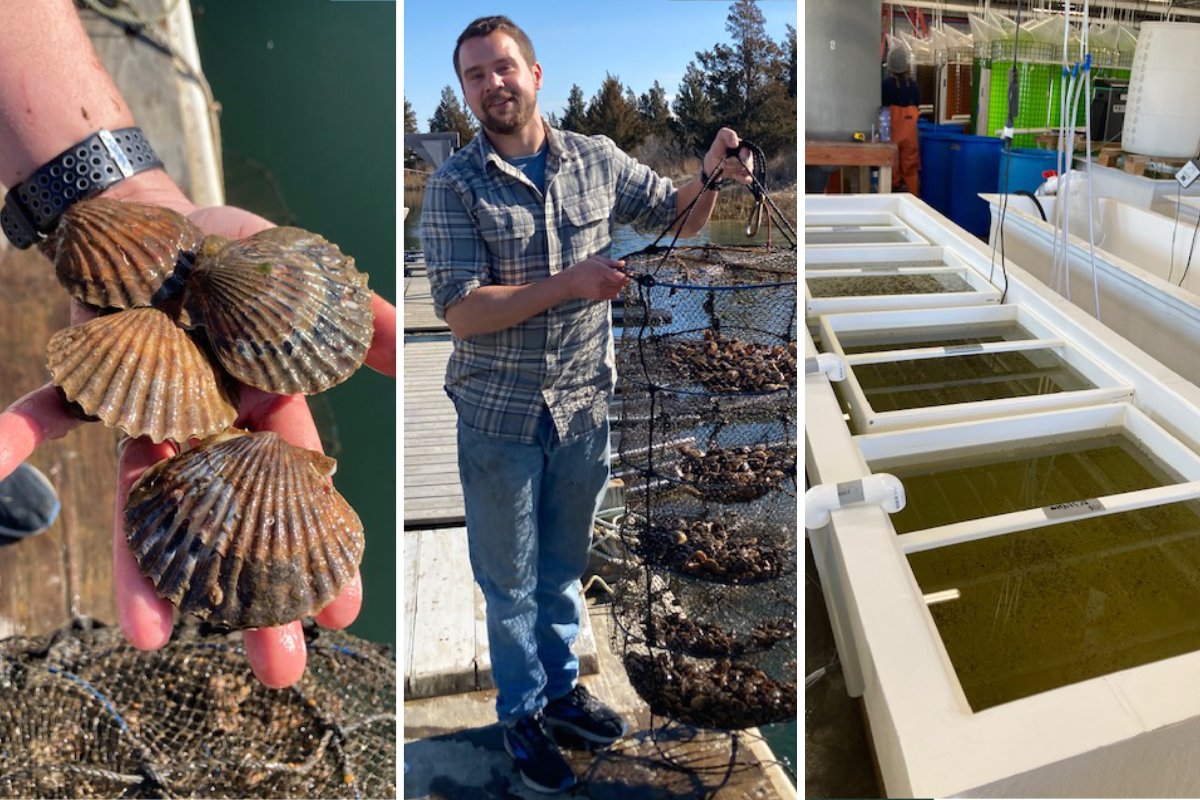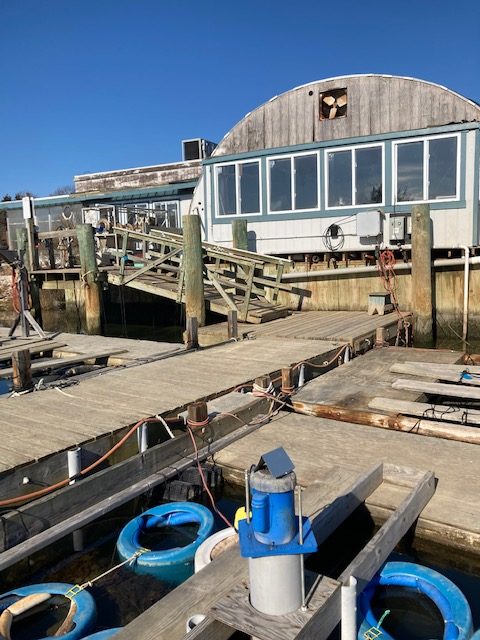Researchers begin selective breeding and other initiatives in hopes of saving the East Coast’s last wild bay scallop fisheries.

Researchers begin selective breeding and other initiatives in hopes of saving the East Coast’s last wild bay scallop fisheries.
March 27, 2023

Adult scallops collected from Peconic Bay that survived the mass die-off, which will be used as broodstock in a 2023 spring spawn (left). CCE’s Harrison Tobi holds lantern nets of juvenile scallops spawned in June 2022 (middle). The spawned scallops are housed in raceways at CCE’s hatchery (right). (Photo credit: Hilary Macht)
Stephen Tettelbach was surveying the bay scallop population in Nantucket with colleagues late in the summer of 2019 when he got the call: A longtime friend and fisherman on Long Island reported a mass die-off of scallops in Peconic Bay, Long Island’s legendary fishery.
Tettelbach, head of the Peconic Bay Scallop Restoration Program at Cornell Cooperative Extension (CCE) in Suffolk County, New York, said his first response was denial. Peconic Bay’s prized shellfish had been thriving in June. In fact, it was supposed to be another banner season—commercial landings in the two preceding years had been the largest since 1994, topping 110,000 pounds.
“There were almost no living scallops anywhere.”
But after returning to Long Island a few days later and setting out on his annual October surveys of Peconic Bay, an estuary nestled between eastern Long Island’s North and South Forks known for its pristine waters, lush eelgrass meadows, and scallops considered to be the best in the country, Tettelbach saw the devastation for himself. “There were almost no living scallops anywhere,” he remembers.
Once the country’s leading bay scallop fishery, Peconic Bay is now holding on for dear life. 2019 marked the first in a series of die-offs that has led to the collapse of one of the few remaining fisheries of wild bay scallops, whose native East Coast populations have declined dramatically in recent decades.
Coastal change in the Northeast is fast outpacing other areas, with summer water temperatures increasing at a rate more than twice the global average, according to research published in Global Change Biology in January.
The research, which involved laboratory and field experiments, found that Peconic Bay’s scallops succumbed to the effects of climate change—to a perfect storm of warmer water temperatures and low levels of dissolved oxygen, likely spurred by summer heat waves. Forthcoming research may also show that parasites played a role.
The study’s authors, including Tettelbach, describe Peconic Bay as a harbinger of things to come and a wake-up call for the country’s few remaining wild bay scallop fisheries, centered mostly in Nantucket and Martha’s Vineyard along the coast of Massachusetts.
In something of a race against time, researchers at Stony Brook University and CCE have joined forces and begun to selectively breed Peconic Bay scallops in an effort to help them resist the effects of climate change and restore their populations. The researchers say the plan offers the best chance of securing the species’ survival in the coming years.
“Our aim is to keep the scallops as wild as possible and to maintain as much genetic diversity as possible,” said Bassem Allam, a shellfish researcher at Stony Brook who is leading the effort. “We want to enhance the scallops’ resistance to environmental stressors as well as to disease.”

Cornell Cooperative Extension’s shellfish hatchery in Southold on Peconic Bay, New York. (Photo credit: Hilary Macht)
To that end, fieldworkers collected surviving scallops from the areas in the bay that were hardest hit by mortality. Those survivors are now being studied for their genetic traits and are serving as broodstock for population lines that will hopefully be able to withstand climate stressors in Peconic Bay.
On a recent chilly, clear morning, Harrison Tobi, an aquaculture specialist at CCE leading the Scallop Restoration Program, pulled lantern nets full of adult scallops from the bay, proudly displaying their progress. “We need not only to adapt to climate change—we need to stay a few steps ahead,” he said.
Even if the bivalves were ultimately able to adapt to their changing habitat and survive, that’s not a sure thing, and either way, time’s not on their side, hence selective breeding. “We’re essentially working to speed up natural selection,” says Tobi.
Tobi and a half-dozen biologists and field workers are spending the winter nurturing scallops in a beachside hatchery just steps from Peconic Bay. The nursery is warm inside and teeming with tanks containing tens of thousands of scallops of different sizes—some no bigger than a pencil eraser, others fully grown, like those outside in the nets.
The plan is to plant one-year-old scallops in several locations in the bay in late May and monitor them over the summer, Allam said. The results should be available this fall.
Meanwhile, about 125 miles northeast in Nantucket, shellfish biologist Tara Riley is taking a volume-driven approach to stabilize another of the nation’s last commercially viable wild bay scallop populations.
Nantucket has had a productive commercial bay scallop fishery for more than 150 years, ever since the whaling industry moved to New Bedford. Over the years, the fishery grew to become another leading producer, with Nantucket Bay scallops considered by many to set the gold standard for the shellfish (although Peconic Bay fans might disagree).
Nantucket’s fishery peaked in the mid-1980s, when annual seasonal harvests topped 100,000 bushels. But pollution in the harbor has taken a toll on the mollusks. 2022 was the worst year of the last decade, Riley said, when fishermen pulled in just 3,500 bushels.
Still, Riley hasn’t lost hope. She’s also hard at work in a shellfish hatchery, preparing to produce and release about 150 million bay scallop larvae into Nantucket and Madaket Harbors over the summer. “Even if 2 percent survive and make it to adulthood and spawn, we’ll be ahead of the game,” Riley said.
In recent decades, wild bay scallop populations have declined steadily and dramatically, essentially disappearing one by one up the coast.
And while the fishery’s current challenges stem mostly from Nantucket Island’s water quality—a result of increased septic loads, fertilizer use, ferry traffic, and stormwater runoff caused by the area’s population growth—climate change may soon add other burdens to the bay.
While Massachusetts’ coastal waters still fall within the safe temperature range for bay scallops—not exceeding 78–80 degrees Fahrenheit for prolonged periods—they are warming at a rate even faster than New York’s, the Global Change Biology study found.
Riley feels lucky that Nantucket is 35 miles out to sea, but acknowledges that dissolved oxygen levels are already lower than they should be in parts of the bay, with scallops from those waters displaying thinner shells. Blister worms, which notoriously live in low-quality sediments and pose a threat to scallops, have also been found in the same areas, she noted.
Bay scallops—filter-feeding bivalved mollusks exquisitely sensitive to their environment—are important both for maintaining water quality and for serving as indicators of the health of their habitat. And unlike clams and oysters, scallops are even more sensitive to their environment when they are in the process of spawning.
A smaller, sweeter cousin of the far more abundant sea scallop, bay scallops—free-living animals with a unique ability to swim using jet propulsion—long inhabited East Coast waters as far south as the Gulf of Mexico. In recent decades, however, wild bay scallop populations have declined steadily and dramatically, essentially disappearing one by one up the coast.
In New Jersey’s Barnegat Bay, 115 miles southwest of Peconic Bay, for instance, wild scallops are long gone. “We haven’t seen wild scallops in Barnegat Bay for years, maybe decades,” said Ximing Guo, a Rutgers University professor and director of its shellfish genetics and breeding program.
Guo is years into a long-term bay scallop aquaculture project, where he’s using selective breeding to produce scallops that grow more quickly to ensure an early harvest. Guo sees his scallops as a local, fresh alternative to the frozen ones from India and China, of which the U.S. is the leading importer.
Still, even as its New Jersey neighbor turns to aquaculture, New York isn’t giving up on its wild shellfish; in fact, it’s betting on Peconic Bay scallops—the so-called jewel of eastern Long Island’s recreational and commercial fishery.
In addition to their substantial commercial value (Peconic Bay’s fishery contributed $60 million annually to the local economy and supported hundreds of jobs for baymen prior to the crash, according to CCE) the scallops have deep cultural and historic roots in the region. Historians say the shellfish functioned as an important food source for the Indigenous peoples who inhabited the area for thousands of years before commercial scalloping began in the mid-1800s and grew substantially over the next century and a half.
In more recent decades, Peconic Bay scallops have garnered iconic, rock-star status, showing up on dinner plates in the most celebrated restaurants throughout the Northeast. They are considered a fall and winter delicacy and a New Year’s tradition for restaurant diners and Long Island locals alike.
But what makes for Peconic Bay’s coastal equivalent of wine grape “terroir”— clear, shallow waters fed by fresh groundwater that help give the scallops their uniquely sweet, delicate flavor and tender flesh—are the same conditions that leave the bay vulnerable to climate change. Warmer temperatures can build in the shallow, protected body of water while dissolved oxygen levels diminish.
“If I didn’t think this would work, I wouldn’t be doing it.”
Peconic Bay’s value is more than regional. The U.S. Department of Commerce’s National Oceanic and Atmospheric Administration declared the Long Island scallop fishery a federal disaster in 2021. And the Nature Conservancy has named the estuary one of the “Last Great Places” in the Western Hemisphere, citing its “rich mosaic of coastal and underwater habitats that support diverse communities and 140 globally and locally rare species.”
While CCE and Stony Brook have taken matters into their own hands, wrestling climate change in the bay with selective breeding, that, of course, is only part of the solution.
“Mitigating further warming by transitioning to clean energy is critical,” said Stephen Tomasetti, visiting assistant professor of environmental studies at Hamilton College in Clinton, New York, and lead author of the recent report in Global Change Biology. “The same goes for committing to practices that improve local water quality.”
The researchers and field workers are acutely aware of how warming waters have impacted other wild shellfish populations in the Northeast. “Lobsters essentially disappeared from Long Island Sound, and we’ve seen the loss of intertidal blue mussels in coastal bays south of Delaware, both a result of increasing summer temperatures,” Tomasetti said.
But there are success stories too, like the selectively bred wild oysters that have been thriving in Chesapeake Bay for at least a decade. As for a return of Peconic Bay scallops, the researchers are more than hopeful: “If I didn’t think this would work,” Allam said, “I wouldn’t be doing it.”

October 9, 2024
In this week’s Field Report, MAHA lands on Capitol Hill, climate-friendly farm funding, and more.
October 2, 2024

October 2, 2024

September 25, 2024

September 25, 2024

September 24, 2024

Like the story?
Join the conversation.